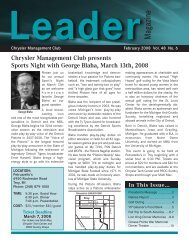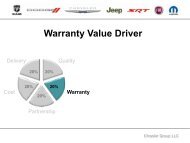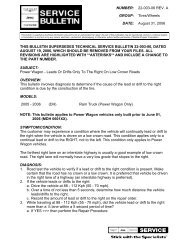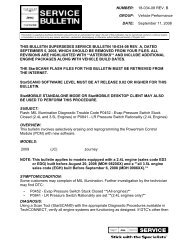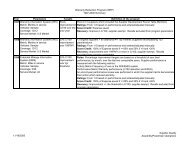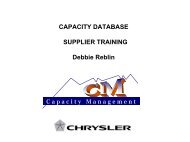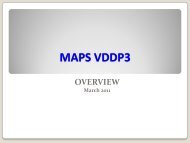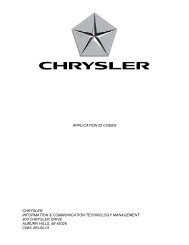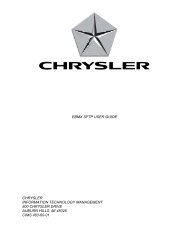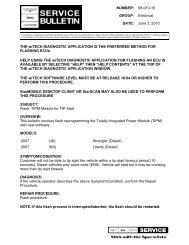Layered Process Audits (LPA) - Chrysler
Layered Process Audits (LPA) - Chrysler
Layered Process Audits (LPA) - Chrysler
Create successful ePaper yourself
Turn your PDF publications into a flip-book with our unique Google optimized e-Paper software.
<strong>Layered</strong> <strong>Process</strong> Audit (<strong>LPA</strong>)<br />
1
Why am I here<br />
today?<br />
2
• Knowledge<br />
Objectives<br />
Be able to explain the rationale behind <strong>LPA</strong>s<br />
Be able to describe how to conduct <strong>LPA</strong>s<br />
Be able to describe the benefits of <strong>LPA</strong>s<br />
• Skills<br />
Be able to to integrate <strong>LPA</strong>s into your plant’s quality system<br />
Be able to develop <strong>LPA</strong> check sheet<br />
Be able to conduct and <strong>LPA</strong> on the factory floor<br />
3
1. Pre- Survey<br />
AGENDA<br />
2. <strong>Layered</strong> <strong>Process</strong> Audit Plan<br />
3. Developing <strong>LPA</strong> Check Sheet<br />
4. <strong>LPA</strong> Implementation<br />
5. Monitor & Adjust Plan<br />
6. Summary<br />
7. Post - Survey<br />
4
1. <strong>Layered</strong> <strong>Process</strong> <strong>Audits</strong> are:<br />
a. A system of audits performed by corporate quality to verify process<br />
conformance<br />
b. A system of audits performed by a 3rd party organization to verify process<br />
conformance.<br />
c. A system of audits performed by multiple levels of management to verify<br />
process conformance.<br />
d. A system of audits performed by operators and line supervisors to verify<br />
process conformance.<br />
2. The two type of <strong>Layered</strong> <strong>Process</strong> <strong>Audits</strong> are:<br />
a. <strong>Process</strong> Control <strong>Audits</strong> and Preventive Maintenance <strong>Audits</strong><br />
b. <strong>Process</strong> Monitoring <strong>Audits</strong> and Error & Mistake Proofing Verification <strong>Audits</strong><br />
c. <strong>Process</strong> Control <strong>Audits</strong> and Error & Mistake Proofing Verification <strong>Audits</strong><br />
3. Who can perform <strong>Layered</strong> <strong>Process</strong> <strong>Audits</strong> (<strong>LPA</strong>)?<br />
a. Auditors trained in <strong>LPA</strong> and TS-16949<br />
b. Certified quality auditors<br />
c. Anyone trained in <strong>Layered</strong> <strong>Process</strong> <strong>Audits</strong><br />
<strong>Layered</strong> <strong>Process</strong> <strong>Audits</strong><br />
PRE/POST TEST<br />
5
4. Who owns the <strong>LPA</strong> process?<br />
a. Manufacturing<br />
b. Quality<br />
c. All of the above<br />
5. The responsibility of the Plant Manager is to:<br />
a. Verify all <strong>LPA</strong> audits are being performed according to schedule<br />
b. Conduct <strong>Process</strong> Control <strong>Audits</strong> on a weekly basis.<br />
c. Review all non-conformances and verify they have permanent corrective action.<br />
d. a and c;<br />
6. Some benefits of <strong>Layered</strong> <strong>Process</strong> <strong>Audits</strong> are.<br />
a. Reduction of build variation and defects<br />
b. Improvement of First Time through capability<br />
c. Facilitation of operator training and improvement of morale<br />
d. a and b;<br />
e. all of the above<br />
<strong>Layered</strong> <strong>Process</strong> Audit<br />
PRE/POST TEST<br />
6
7. Which of the following is not a part of developing the <strong>LPA</strong> plan?<br />
a. Form a <strong>Layered</strong> <strong>Process</strong> Audit team<br />
b. Obtain <strong>Chrysler</strong> SQA approval of plan<br />
c. Develop audit checklist<br />
d. Determine audit frequency<br />
8. The <strong>Layered</strong> <strong>Process</strong> Audit is _________ focused?<br />
a. Part<br />
b. <strong>Process</strong><br />
c. Part and process<br />
9. During the <strong>Layered</strong> <strong>Process</strong> Audit the auditor should randomly select process<br />
and/or product characteristics to be measured to ensure they are within<br />
specification?<br />
a. True<br />
b. False<br />
<strong>Layered</strong> <strong>Process</strong> Audit<br />
PRE/POST TEST<br />
7
We’re<br />
Looking for<br />
PERFECT<br />
PARTS<br />
Throughout<br />
the Supply<br />
“Cost of failure after launch is 20 times<br />
more expensive than prevention costs<br />
during launch”<br />
Chain<br />
8
DFMEA<br />
<strong>LPA</strong><br />
PRODUCTION<br />
DEMONSTRATION RUN<br />
PFMEA<br />
CONTROL PLAN<br />
Toolbox<br />
TOOLING, EQUIPMENT, GAGES ENGINEERING STANDARDS<br />
AQP TIMING CHART<br />
SE<br />
TS16949 FOREVER<br />
APPEARANCE<br />
REQUIREMENTS<br />
PV<br />
PSO APPROVAL<br />
AQP/PSO<br />
PREVENTATIVE<br />
MAINTENANCE<br />
FPSC<br />
PPAP<br />
KEY CHARACTERISTICS<br />
KEY PERSONNEL WORK INSTRUCTIONS<br />
AND KEY PERSONNEL TRAINING<br />
EMP(ERROR/MISTAKE PROOFING)<br />
PROCESS CAPABILITY<br />
BOUNDARY SAMPLES<br />
INCOMING AND<br />
OUTGOING MATERIAL<br />
SUPPLIER WARRANTY PARTS PLAN<br />
NCT<br />
GATE REQUIREMENTS AQP<br />
LESSONS LEARNED<br />
9
Cost of Non-Conformances Non Conformances at Various<br />
Points<br />
Defect found at:<br />
The Next End of User’s User<br />
Final End<br />
Source <strong>Process</strong> Line Inspection Hand<br />
*Very minor *Scrap *Repair *Significant Rework Rework<br />
*3rd Party Containment<br />
*Minor Delay *Containment *Additional Operations Operations<br />
*Premium<br />
Freight<br />
*Rework *Overtime<br />
*Administrative costs<br />
*Reschedule *Reschedule<br />
*Delay in delivery<br />
*Warranty Early Costs<br />
Detection / Prevention<br />
10<br />
of Work Work<br />
*Added inspection<br />
*Reputation
Supplier Interface – <strong>LPA</strong> is <strong>Chrysler</strong><br />
Mandatory Requirement<br />
ISO/ TS 16949<br />
<strong>Chrysler</strong> Customer Specific Requirements<br />
New section under Internal <strong>Audits</strong><br />
Effective 7/01/04 for Powertrain & Component Plants suppliers;<br />
1/1/05 for all remaining suppliers<br />
Posted on AIAG, IAOB, and QMS web sites<br />
Letter mailed to all suppliers<br />
<strong>LPA</strong> is a new Quality Tool.<br />
11
1. <strong>Layered</strong> <strong>Process</strong> Audit Plan<br />
<strong>LPA</strong> Definitions and<br />
Requirements<br />
<strong>LPA</strong> Benefits<br />
<strong>LPA</strong> Plan<br />
12
<strong>LPA</strong> Definitions and Requirements<br />
What Are <strong>Layered</strong> <strong>Process</strong> <strong>Audits</strong>?<br />
<strong>Layered</strong> <strong>Process</strong> <strong>Audits</strong> (<strong>LPA</strong>) are a system of audits performed<br />
by multiple levels of management. Key process characteristics are<br />
audited frequently to verify process conformance.<br />
The purpose of <strong>Layered</strong> <strong>Process</strong> <strong>Audits</strong> is to ensure continuous<br />
conformance, thereby improving process stability and first-time<br />
through capability. (As required by <strong>Chrysler</strong> Group TS Customer<br />
Specifics (4.2.1.9.1)<br />
13
<strong>LPA</strong> Definitions and Requirements<br />
What is a <strong>Layered</strong> <strong>Process</strong> Audit?<br />
<strong>LPA</strong> is an ongoing system of process checks that verify<br />
proper methods, settings, operator craftsmanship, error<br />
proofing devices and other inputs are in place to ensure<br />
a defect free product.<br />
<strong>LPA</strong>’s assure that defined methods and work<br />
instructions are utilized, problem solving solutions are<br />
held in place, and all process issues are identified and<br />
quickly corrected.<br />
14
<strong>LPA</strong> Definitions and Requirements<br />
There are Two Types of <strong>Layered</strong><br />
<strong>Process</strong> <strong>Audits</strong>:<br />
<strong>Process</strong> Control <strong>Audits</strong> should be conduct on any<br />
process with customer complaint issues, high risk<br />
elements [PFMEA] and key characteristics that affect<br />
part quality. <strong>Process</strong> Control <strong>Audits</strong> shall be performed<br />
once per shift by supervisors. Plant management shall<br />
perform the audit once per week.<br />
Error & Mistake Proofing Verification audits shall<br />
be conducted on all error/mistake proofing techniques.<br />
They shall be conducted once per shift at the start of<br />
each shift. Only qualified employees shall perform Error<br />
& Mistake Proof Verification <strong>Audits</strong>. Set-up, Set up,<br />
maintenance or quality auditors are usually qualified.<br />
15
<strong>LPA</strong> Definitions and Requirements<br />
How does an <strong>LPA</strong> Work?<br />
LAYERED PROCESS<br />
AUDITS ARE PROCESS<br />
BASED, NOT PART<br />
BASED.<br />
<strong>Process</strong> <strong>Audits</strong><br />
PROCESS Error<br />
Proofing<br />
Continuous<br />
Improvement<br />
Inputs<br />
Corrective<br />
Actions<br />
Prevention<br />
Actions<br />
Employee<br />
Workshops<br />
•<strong>Audits</strong> are conducted regularly by all levels of supervision<br />
•Non-conformances are immediately addressed<br />
16
<strong>LPA</strong> Definitions and Requirements<br />
Who Performs <strong>Layered</strong> <strong>Process</strong> <strong>Audits</strong>?<br />
Anybody can perform a <strong>Layered</strong> <strong>Process</strong> Audit.<br />
Manufacturing management must own the process and perform audits.<br />
All managers, regardless of function, can be auditors. 。<br />
Each management level should perform audits.<br />
17
<strong>LPA</strong> Benefits<br />
• Improved process stability & reduce variation<br />
• Prevents process errors and operator mistakes<br />
• Improves and maintains discipline<br />
• Initiates Continuous Improvement actions<br />
• Lower Rework & Repair<br />
• Reduces scrap and eliminates waste<br />
• Improves communication<br />
• Instills and improves standardization<br />
• Improves overall Quality and reduces costs<br />
• FTC in high 90%<br />
• Initiates continuous improvement actions<br />
• Early detection & prevention<br />
18
<strong>LPA</strong> Benefits<br />
Reduces<br />
Improves<br />
Facilitates<br />
Reinforces<br />
•Build variation based on work standardization<br />
•End-of-line inspection<br />
•Part defects<br />
•First time through capability<br />
•Morale<br />
•Operator training<br />
•Management/operator interface<br />
•Safety regulations<br />
19
The <strong>Chrysler</strong> Kokomo Transmission Plant<br />
<strong>LPA</strong> Success Story<br />
<strong>LPA</strong><br />
has achieved significant gains in FTC using <strong>LPA</strong>.<br />
FTC in the high 90%<br />
Rework now minimal<br />
Improvements correlate with <strong>LPA</strong> deployment<br />
Number of <strong>LPA</strong><br />
Checks Per Week<br />
Repair Inventory vs FTC vs <strong>LPA</strong><br />
Repair Inventory FTC<br />
540<br />
0 <strong>LPA</strong><br />
180<br />
180<br />
18-02<br />
21-02<br />
24-02<br />
27-02<br />
30-02<br />
33-02<br />
36-02<br />
39-02<br />
42-02<br />
45-02<br />
48-02<br />
51-02<br />
1-03<br />
4-03<br />
7-03<br />
10-03<br />
13-03<br />
16-03<br />
19-03<br />
22-03<br />
25-03<br />
28-03<br />
31-03<br />
34-03<br />
37-03<br />
40-03<br />
43-03<br />
46-03<br />
49-03<br />
52-03<br />
Weekly<br />
It worked for us,<br />
it can work for you<br />
and<br />
your Suppliers!<br />
KTP Now conducting 6700<br />
<strong>Process</strong> <strong>Layered</strong> Audit<br />
100<br />
95<br />
90<br />
85<br />
80<br />
75<br />
70<br />
65<br />
60<br />
55<br />
%FTC<br />
20
<strong>LPA</strong> Benefits<br />
Proven Successful Internally<br />
Expanding Collaboration to our Supply base<br />
Not asking Suppliers to do something we are not<br />
Low investment – significant quality return<br />
21
<strong>LPA</strong> Plan<br />
<strong>LPA</strong> Plan Elements<br />
1. Form <strong>LPA</strong> Team<br />
2. Design Audit Check Sheet<br />
3. Develop <strong>LPA</strong> Implementation Procedures<br />
4. Develop Monitoring <strong>Process</strong><br />
5. Reporting Results to <strong>Chrysler</strong><br />
6. Execute Plan<br />
22
Form <strong>LPA</strong> Team<br />
<strong>LPA</strong> Plan<br />
Form a Team: Select team members that are multi-functional multi functional and<br />
multi-level: multi level: Managers, Supervisors, Inspectors, and Operators<br />
from all areas such as Manufacturing, Quality Engineering, and<br />
Maintenance.<br />
Upper Management: Need to be included as team members.<br />
<strong>Process</strong> Owner: Should be someone within plant management.<br />
Team Leader: Should be the person responsible for overseeing<br />
implementation.<br />
Empower the Team: The team must be able to make necessary<br />
decisions related to <strong>LPA</strong>.<br />
Support: All management must be notified to provide immediate<br />
support when requested.<br />
Schedule frequent meetings: Meetings should be scheduled to<br />
review<br />
<strong>LPA</strong> results, track corrective actions and make adjustments.<br />
adjustments.<br />
Action Plan: Develop an action plan to identify all<br />
implementation steps.<br />
Periodic Reviews of Action Plan: Management team should<br />
schedule<br />
23
<strong>LPA</strong> Plan<br />
<strong>LPA</strong> Leadership Role<br />
<strong>LPA</strong> calls for substantial commitment of management’s time and effort.<br />
Leadership’s role is to:<br />
Fix system problems<br />
Instill discipline<br />
Show appreciation to operators for doing work correctly<br />
Encourage improvement ideas from the workforce<br />
All plant staff should conduct <strong>Layered</strong> <strong>Process</strong> <strong>Audits</strong> throughout the plant<br />
During early phase - Management audits will find problems, but later the<br />
management audits will find improvements.<br />
24
<strong>LPA</strong> Plan<br />
Supplier’s Supplier s review & Approval<br />
Supplier shall conduct internal review of <strong>LPA</strong> Plan<br />
<strong>LPA</strong> plan to include <strong>LPA</strong> implementation timing<br />
Supplier shall finalize <strong>LPA</strong> plan<br />
Shall be signed – off by <strong>LPA</strong> team & Plant Manager prior to<br />
approval<br />
from your customer<br />
For Medium and High risk parts, both the <strong>LPA</strong> plan and<br />
demonstration shall be approved by the Supplier Quality<br />
Specialist.<br />
25
Example:<br />
<strong>LPA</strong> Plan<br />
26
Example:<br />
<strong>LPA</strong> Plan<br />
27
Customer Complaints, Quality Alerts<br />
<br />
<br />
<br />
<br />
<br />
<br />
<br />
<br />
First-Time Through data, Scrap Reports<br />
Key Characteristics and <strong>Process</strong> Capability: Cpk & Gage R&R<br />
PFMEA, <strong>Process</strong> Flow Diagram, Control Plan<br />
Set-up Sheets, Work Instructions, Inspection Instructions<br />
Error and Mistake Proofing<br />
Quality System <strong>Audits</strong>, Dock <strong>Audits</strong>, Inspection Reports<br />
Rework instructions<br />
2. . Developing <strong>LPA</strong><br />
Check Sheet<br />
<strong>LPA</strong> Check Sheet Input<br />
28
2. . Developing <strong>LPA</strong><br />
Check Sheet<br />
The Area of Highest Risk should be the first area to implement the<br />
<strong>Layered</strong> <strong>Process</strong> Audit<br />
This area will also be used as a Lessons Learned for implementing the<br />
<strong>Layered</strong> <strong>Process</strong> Audit across the entire manufacturing facility.<br />
Use Discretion when adding items to the checklist<br />
Audit items are issues that would cause Customer Dissatisfaction.<br />
29
2. . Developing <strong>LPA</strong> Check Sheet<br />
Typical Audit Elements For…<br />
Assembly / Fabrication<br />
(Manually Dependent <strong>Process</strong>es)<br />
Craftsmanship<br />
Operation movement<br />
Proper product identification<br />
Presence & content of<br />
instructions<br />
Presence & content of visual<br />
aids<br />
Sustainment of 5S<br />
workplace<br />
Touchpoint inspections<br />
Checking of customer used<br />
features<br />
Use of manual assists<br />
Packing and stacking<br />
techniques<br />
Placement of labels<br />
Calibration of gages<br />
Inspection plan being<br />
followed<br />
Torque monitoring<br />
Completion of<br />
documentation<br />
Error & mistake proofing<br />
nonconformance testing<br />
30
2. . Developing <strong>LPA</strong> Check Sheet<br />
Typical Audit Elements For…<br />
Machining/Robotics<br />
(Automation Driven <strong>Process</strong>es)<br />
Preventative<br />
Maintenance<br />
Calibration of gages<br />
Technical parameters<br />
Set-up Set up procedures<br />
Machine settings<br />
<strong>Process</strong> sheets<br />
Tool change<br />
verification<br />
Positioning of coolant<br />
lines<br />
Die coloration<br />
Gage plan<br />
Sample part retention<br />
Documentation of gage<br />
checks<br />
SPC data capture and<br />
charting<br />
Mastering of gages<br />
Error & mistake proofing<br />
nonconformance testing<br />
31
2. . Developing <strong>LPA</strong> Check Sheet<br />
Audit Question Criteria …<br />
Each audit question should ask HOW?<br />
WHAT? And WHY?<br />
Questions: Objective, Specific & Concise<br />
Explanation: Reason for Check<br />
Reaction Plan: What to do if non-conformance<br />
non conformance<br />
Countermeasure: Measurement to protect<br />
customer<br />
32
2. . Developing <strong>LPA</strong> Check Sheet<br />
How to Develop Questions… Questions<br />
Objective:<br />
After looking at evidence vs stated criteria, can be easily<br />
answered<br />
with a “Yes” or a “No”.<br />
Specific:<br />
Avoid unclear terms like properly or correctly<br />
Concise:<br />
Critical to quality<br />
Conducted by people unfamiliar with area<br />
33
Making Questions Specific (Example #1)<br />
Initial Question :<br />
Inspection Log Book: Look and see if the log<br />
is being filled out properly and checks are<br />
What? being made.. What?<br />
How ?<br />
made.<br />
Improved Question :<br />
Inspection Log Book: Verify QAFM250092 is being<br />
filled out with date, shift, badge and checks are<br />
being made. (Missing or Incorrect data could<br />
result in incorrect units being held in the event of<br />
a containment.)<br />
Why?<br />
34
Making Questions Specific (Example #1)<br />
Initial Question :<br />
Pressure Dial Settings: Look and see if the<br />
pressure dial is being properly set.<br />
What How<br />
Improved Question :<br />
Hydraulics Pressure Dial Settings (Right): Verify<br />
Pressure dial is set to 450 psi prior to start-up. start up. If<br />
not set to 450 psi contact maintenance prior to<br />
operation. (Verification of Hydraulics pressure dial<br />
settings ensures machine operates within the<br />
correct press force range.)<br />
Why<br />
35
2. . Developing <strong>LPA</strong> Check Sheet<br />
OPERATIO<br />
N<br />
or<br />
PROCESS<br />
RECEIVING<br />
INSPECTION<br />
INJECTION<br />
WELDING<br />
ASSEMBLY<br />
<strong>LPA</strong> CHECKLIST QUESTION CORRECTIVE ACTION<br />
If parts are tagged with red Non-Conformance Non Conformance Tag, is<br />
the tag complete with 1) part number, 2) date and 3)<br />
description of the discrepancy 4) disposition?<br />
Verify machine process settings are correct as per the<br />
set-up set up sheet.<br />
Verify that the operators are checking for and<br />
removing any flash from edges of the molded part<br />
Verify that the operators are documenting flash<br />
removal on operator inspection form.<br />
Is the operator using the digital dial-indicator dial indicator to check<br />
the stake height of assembly as per inspection<br />
instructions?<br />
Verify that the #2 temperature gage reads between<br />
140 and 150 degrees Fahrenheit<br />
Verify the operator is applying grease on both the<br />
spring and pivot pin<br />
Verify on three assemblies that the parts are free of<br />
excess grease and flash.<br />
Verify that the handle operates smoothly without<br />
Notify Receiving Inspection<br />
Supervisor.<br />
Notify Molding Manager. Inform<br />
Quality Inspector to begin<br />
containment.<br />
Notify Molding Manager. Inform<br />
Quality Inspector to begin<br />
containment and initiate a C.A.R..<br />
Notify department supervisor.<br />
Notify department supervisor.(Error<br />
Detection device at next station is set<br />
to reject nonconforming parts.)<br />
Notify area supervisor and<br />
Engineering Manager. Inform Quality<br />
Inspector to begin containment.<br />
Notify Assembly Supervisor Inform<br />
Quality Inspector to begin<br />
containment and initiate a C.A.R..<br />
Notify Assembly Supervisor Inform<br />
Quality Inspector to begin<br />
containment.<br />
36<br />
Notify Assembly Supervisor Inform
2. Developing <strong>LPA</strong> Check Sheet<br />
Make sure EACH process has its own specific <strong>LPA</strong><br />
Complete <strong>LPA</strong>s at the beginning of shift(s) shift(s<br />
Critical plant processes are addressed<br />
All “No No’s” or non-conformances non conformances should be addressed<br />
immediately<br />
Do not ever consider an <strong>LPA</strong> as final. It is a living<br />
document that should be updated regularly with corrective<br />
actions, error-mistake error mistake proofing, etc.<br />
Do not create one <strong>LPA</strong> for a whole facility. Do not make an<br />
<strong>LPA</strong> generic.<br />
37
2. Developing <strong>LPA</strong> Check Sheet<br />
Items are NEVER removed unless there is a<br />
product/process change or improvement.<br />
<strong>Audits</strong> should include visual checks<br />
“Verify Verify somebody doing something right.” right.<br />
All quality issues should be addressed with<br />
corrective action updated in the <strong>LPA</strong>s. <strong>LPA</strong>s<br />
If separate part numbers, or different<br />
customer’s customer s parts share a common line, it should<br />
be audited at different times to include all parts.<br />
38
3. <strong>LPA</strong> Implementation<br />
<strong>LPA</strong> Implementation Plan<br />
Elements…<br />
Elements<br />
<strong>LPA</strong> Structure & Frequency<br />
Check sheets for each <strong>Process</strong><br />
Training of Employees<br />
Tracking Issues & Compliance<br />
Non-Conformance Non Conformance Corrective Action<br />
Procedure<br />
Management Review of <strong>LPA</strong> Results<br />
39
<strong>LPA</strong> Structure & Frequency<br />
<strong>Process</strong> Control Audit<br />
Once per shift done by group leaders or supervisors<br />
Management performs audits weekly<br />
Divide manufacturing areas and rotate so all areas are audited<br />
Error & Mistake Proofing Verification Audit<br />
Once per shift, at the start of each shift, done by Maintenance, Set-up<br />
or Quality Auditor<br />
Minimum frequency requirements shall be met.<br />
Any scheduled audit must be performed to maintain discipline and<br />
improve quality.<br />
40
<strong>LPA</strong> Structure & Frequency<br />
Plant Manager<br />
1 X Week<br />
Area Management<br />
2 X Week<br />
Production Supervisor<br />
1 X Shift<br />
• Encourages Management Involvement<br />
• Encourages Operator Feedback<br />
• Establishes Accountability<br />
41
EXAMPLE: <strong>LPA</strong> FREQUENCY AND STRUCTURE<br />
42
Train Auditors<br />
Training of Employees<br />
Once the <strong>LPA</strong> plan is approved, the Supplier shall train their <strong>Layered</strong><br />
<strong>Process</strong> Auditors.<br />
Auditors must understand <strong>LPA</strong> strategy and purpose.<br />
Review checklist and reactions with auditors<br />
Auditors must know to respond immediately after finding a<br />
nonconformance.<br />
EMPV Auditors shall be qualified to perform error and mistake proofing<br />
verification.<br />
Perform a practice audit where appropriate.<br />
43
Notify Workforce<br />
Explain why the <strong>LPA</strong> is being implemented.<br />
Explain the purpose and benefits of the <strong>LPA</strong> process.<br />
Inform workforce of <strong>LPA</strong> activity and what to expect when audits are<br />
performed in their work areas.<br />
Encourage workforce feedback.<br />
Training of Employees<br />
Communicate <strong>LPA</strong> results frequently.<br />
44
Corrective Actions shall be documented as required by ISO/TS<br />
Summary of audit results: Pareto of non-conformances<br />
non conformances<br />
Frequency of Management Review<br />
Management Reaction Plan for <strong>LPA</strong> <strong>Process</strong> Audit Schedule & Tracking Tracking<br />
system<br />
Develop<br />
.<br />
Tracking Issues & Compliance<br />
- Corrective Action Request forms for non-conformnces<br />
non conformnces<br />
- Summary of on-time/missed/late on time/missed/late audit completion<br />
There must be a system to maintain the audit schedule and track<br />
completion.<br />
.<br />
45
Tracking Issues & Compliance<br />
Review audit results frequently when starting process.<br />
Improve audit checklist based on auditor feedback.<br />
Management must instill discipline early in the process to complete audits<br />
on time and provide resources for immediate corrective action.<br />
Develop and apply Lessons Learned to improve audit.<br />
If audit issue is found, work for corrective action that is within TAKT time.。<br />
46
<strong>LPA</strong>s used as a training tool – new supervisors, new<br />
shift of associates.<br />
Clipboard required!<br />
Tracking Issues & Compliance<br />
Do NOT push 100% compliance! Make problems<br />
visible.<br />
Have a “system system” to deal with audit item non-<br />
compliance.<br />
Track non-compliances non compliances and report out at plant<br />
manager level.<br />
<strong>LPA</strong> should be completed by plant management- management No<br />
delegating allowed!<br />
47
4. Monitor & Adjust Plan<br />
Develop a Monitoring <strong>Process</strong> and<br />
Reports for Management Review.<br />
Improvements driven by the <strong>LPA</strong><br />
process shall be measured,<br />
monitored, and reported to<br />
management as per <strong>Chrysler</strong> Group TS<br />
Customer Specifics (4.2.1.9.1).<br />
48
Example:<br />
4. Monitor & Adjust Plan<br />
49
Example:<br />
4. Monitor & Adjust Plan<br />
50
Manufacturing Location Summary<br />
cators<br />
Line Supervisor Plan vs. Actual<br />
40<br />
20<br />
0<br />
Jan Mar May Jul Sep Nov<br />
No. of Total <strong>LPA</strong> Auditable Items Planned 计划<br />
No. of Total <strong>LPA</strong> Auditable Items Actual 实际<br />
Top Management Plan vs. Actual<br />
高层管理计划与实际的比较<br />
100<br />
50<br />
0<br />
Jan Mar May Jul Sep Nov<br />
No. of Total <strong>LPA</strong> Auditable Items Planned 计划<br />
No. of Total <strong>LPA</strong> Auditable Items Actual 实际<br />
4. Monitor & Adjust Plan<br />
Middle Management Plan vs. Actual<br />
100<br />
50<br />
0<br />
Jan Mar May Jul Sep Nov<br />
No. of Total <strong>LPA</strong> Auditable Items Planned 计划<br />
No. of Total <strong>LPA</strong> Auditable Items Actual 实际<br />
Please note请注意:<br />
1. This shows three levels of management. <strong>Chrysler</strong><br />
Group TS requirements state that the supplier must<br />
have “multiple levels” of management.<br />
2. The number of <strong>LPA</strong> auditable items refers to the number<br />
of items on the <strong>LPA</strong> checklist multiplied by the<br />
number of times the items are checked in that month.<br />
51
4. Monitor & Adjust Plan<br />
Manufacturing Location Summary<br />
cators<br />
FTC<br />
100%<br />
80%<br />
60%<br />
40%<br />
20%<br />
0%<br />
Jan Mar May Jul Sep Nov<br />
FTC<br />
<strong>LPA</strong> Non-Conformance Corrective<br />
Action Status<br />
50<br />
0<br />
Jan Mar May Jul Sep Nov<br />
Open 未解决 Closed 已解决<br />
52
5. Summary<br />
The <strong>LPA</strong> is an audit of the process. process<br />
The <strong>LPA</strong> checklist is a living document. Plant<br />
Management must remain involved and committed<br />
to the <strong>LPA</strong> process.<br />
The Customer shall review <strong>LPA</strong> as part of corrective<br />
action (s) for quality issues.<br />
53
Start Up / Shut Down<br />
<strong>Layered</strong> <strong>Process</strong> Audit (<strong>LPA</strong>)<br />
54
Start Up / Shut Down<br />
<strong>Layered</strong> <strong>Process</strong> Audit<br />
Improvement Strategy<br />
Increase <strong>LPA</strong> expectations around shut<br />
down events<br />
– Increase <strong>LPA</strong> frequency prior to and post<br />
shut down<br />
– Extra attention on:<br />
__ Job Set Up<br />
__ Containment Activities<br />
__ Error/Mistake Proofing<br />
55
Normal<br />
<strong>Layered</strong> <strong>Process</strong> Audit<br />
Purpose<br />
Ensure continuous conformance,<br />
improve process<br />
stability and first-time first time-through through<br />
capability.<br />
Benefits<br />
Improves quality, productivity, and<br />
cost<br />
Creates engaged workforce –<br />
prevents errors<br />
Improves communication and<br />
standardization<br />
Allows constant identification of<br />
“biggest opportunities”<br />
Creates effective deployment of<br />
resources<br />
Expectations<br />
<strong>LPA</strong> audits performed by multiple<br />
levels of management<br />
Top management at plant<br />
conducting <strong>LPA</strong>’s at least once per<br />
week<br />
<strong>LPA</strong>’s conducted at least once per<br />
shift for build techniques and<br />
craftsmanship related processes,<br />
and once per day on all Error<br />
Lessons<br />
Learned<br />
<strong>LPA</strong><br />
<strong>LPA</strong><br />
Checklist<br />
Checklist<br />
Management<br />
Review Team<br />
<strong>LPA</strong> Action<br />
Plans<br />
<strong>LPA</strong> Audit<br />
Teams<br />
Error &<br />
Mistake<br />
Proofing<br />
Verification<br />
56
Start Up / Shut Down<br />
<strong>Layered</strong> <strong>Process</strong> Audit<br />
Purpose<br />
Ensure continuous conformance,<br />
improve process<br />
stability and first-time first time-through through<br />
capability.<br />
Start Up / Shut Down<br />
Benefits<br />
Improves quality, productivity, and<br />
cost<br />
Creates engaged workforce –<br />
prevents errors<br />
Improves communication and<br />
standardization<br />
Allows constant identification of<br />
“biggest opportunities”<br />
Creates effective deployment of<br />
resources<br />
Expectations<br />
<strong>LPA</strong> audits performed by multiple<br />
levels of management<br />
Top management at plant<br />
conducting <strong>LPA</strong>’s at least once per<br />
week<br />
<strong>LPA</strong>’s conducted at least once per<br />
shift for build techniques and<br />
craftsmanship related processes,<br />
and once per day on all Error<br />
Start<br />
Up<br />
Check<br />
List<br />
Looking for<br />
high risk<br />
potential<br />
Plant<br />
manager<br />
& Direct<br />
reports<br />
<strong>LPA</strong> Audit<br />
Teams<br />
<strong>LPA</strong><br />
<strong>LPA</strong><br />
Checklist<br />
Checklist<br />
Normal <strong>LPA</strong><br />
Keep Eye On<br />
The Ball<br />
57
Start Up / Shut Down<br />
<strong>Layered</strong> <strong>Process</strong> Audit<br />
Things for you to consider:<br />
1. Modify the Start Up / Shut Down <strong>LPA</strong><br />
to your plant processes/needs<br />
2. Instruct people on role:<br />
First line - Use normal <strong>LPA</strong><br />
Top Management - use Start Up /<br />
Shut Down <strong>LPA</strong><br />
3. Drive the <strong>LPA</strong> schedule<br />
30 days before shut down<br />
30 days after shut down<br />
4. Use it at your own discretion<br />
58
Date:______________Project<br />
#______________<br />
Item # <strong>LPA</strong> Question Expectations Y/N Corrective Action & Timing<br />
1<br />
2<br />
3<br />
4<br />
5<br />
• SHIFT DOWN / START OF PRODUCTION<br />
All questions are to be answered with a "Y" for yes (acceptable or compliant), or "N"<br />
for no (unacceptable or non-compliant) in the status box.<br />
Non-compliances are to have corrective action with timing recorded in the space<br />
pro ided<br />
Assumptions for using this document:<br />
- Intent of these questions is that the operator is performing a new operation.<br />
- Normal <strong>LPA</strong> is being followed.<br />
O i f t i i i l<br />
MANPOWER TURNOVER & RE-LEARNING<br />
Do you know the percentage of<br />
new Operators for the process?<br />
Percentage: %<br />
Is there a documented process<br />
for training new operators, and are<br />
records of training kept?<br />
Have Control Plan frequencies and<br />
sample sizes been increased to<br />
reflect the increased risk of<br />
nonconformances during the<br />
learning curve period?<br />
Is the process unchanged since<br />
the operator last performed the<br />
task?<br />
Are the operators following the<br />
posted operator instructions, and<br />
are the work insrtuctions up-todate?<br />
Management has a clear<br />
perspective of the number of new<br />
operators on each job. This needs<br />
to drive training plan and an<br />
enhanced control plan during the<br />
learning curve period.<br />
Untrained operators pose risk to<br />
assembly. Only certified operators<br />
are allowed to perform specific<br />
tasks without backup.<br />
The risk of nonconformances is<br />
highest as operators are learning a<br />
process. Inspection frequencies<br />
should be increased to<br />
compensate.<br />
Operators require education of<br />
process changes or deviations that<br />
could effect their job.<br />
Confirm operators are following the<br />
correct operator instructions.<br />
59
Date:______________Projec<br />
t#<br />
Item # <strong>LPA</strong> Question Expectations Y/N Corrective Action & Timing<br />
6<br />
7<br />
8<br />
• SHIFT DOWN / START OF PRODUCTION<br />
All questions are to be answered with a "Y" for yes (acceptable or compliant),<br />
or "N" for no (unacceptable or non-compliant) in the status box.<br />
N li t h ti ti ith ti i d d i th<br />
Assumptions for using this document:<br />
- Intent of these questions is that the operator is performing a new operation.<br />
- Normal <strong>LPA</strong> is being followed.<br />
- On-going manufacturing process remains in place.<br />
Do you have a plan to<br />
rebalance, or have you already<br />
rebalanced, the process (if<br />
necessary)?<br />
If the process needs to be<br />
rebalanced, have you reverified<br />
the process, such as<br />
with a <strong>Process</strong> Sign-Off?<br />
If the process needs to be<br />
rebalanced, have you gotten<br />
approval from <strong>Chrysler</strong> for any<br />
process changes necessary<br />
through the "Forever"<br />
Requirements system?<br />
Line rebalancing may be<br />
necessary to account for lower<br />
volumes and reduced manpower<br />
available.<br />
Confirmation of process<br />
capability, FTC, etc. after<br />
rebalancing.<br />
Get approval from <strong>Chrysler</strong> for<br />
all process changes prior to<br />
implementing those changes.<br />
60
Date:______________Project<br />
#______________<br />
Item # <strong>LPA</strong> Question Expectations Y/N Corrective Action & Timing<br />
9<br />
10<br />
11<br />
• SHIFT DOWN / START OF PRODUCTION<br />
All questions are to be answered with a "Y" for yes (acceptable or compliant), or<br />
"N" for no (unacceptable or non-compliant) in the status box.<br />
Non-compliances are to have corrective action with timing recorded in the space<br />
Assumptions for using this document:<br />
- Intent of these questions is that the operator is performing a new operation.<br />
- Normal <strong>LPA</strong> is being followed.<br />
- On-going manufacturing process remains in place.<br />
MAINTENANCE ACTIVITIES<br />
Have maintenance activities<br />
been continued as scheduled?<br />
Are maintenance Set-Up parts<br />
controlled and segregated? Are<br />
parts identified / labeled? Is<br />
there a designated location for<br />
maintenance parts? Is there a<br />
process to confirm the quality<br />
of parts produced during<br />
maintenance or set-up activity<br />
(e.g. First Pi<br />
Have all maintenance/setup<br />
parts been purged from Work<br />
Cell areas? Have questionable<br />
parts produced during<br />
maintenance efforts been<br />
quarantined?<br />
Maintenance schedule must be<br />
maintained.<br />
Set-up parts, boundary samples,<br />
etc. must be controlled to avoid<br />
mixing with production parts.<br />
Set-up parts, boundary samples,<br />
etc. must be controlled to avoid<br />
mixing with production parts.<br />
61
12<br />
13<br />
14<br />
15<br />
• SHIFT DOWN / START OF PRODUCTION<br />
All questions are to be answered with a "Y" for yes (acceptable or compliant), or<br />
"N" for no (unacceptable or non-compliant) in the status box.<br />
Non-compliances are to have corrective action with timing recorded in the space<br />
Assumptions for using this document:<br />
- Intent of these questions is that the operator is performing a new operation.<br />
- Normal <strong>LPA</strong> is being followed.<br />
- On-going manufacturing process remains in place.<br />
Have you verified expiration<br />
dates or shelf-life of raw<br />
materials, WIP, and finished<br />
goods?<br />
MATERIALS<br />
Are all material expiration dates<br />
tracked and maintained?<br />
Are material maintenance<br />
requirements being followed?<br />
Are all materials at the work<br />
station acceptable (i.e. not past<br />
their expiration date)?<br />
Materials may sit unused for<br />
longer periods of time during<br />
periods of low volume<br />
production.<br />
Inventory control process are<br />
followed (e.g. FIFO)<br />
Materials are being stored<br />
correctly; e.g. humidity<br />
requirements, temperature levels,<br />
covered if required, Agitation<br />
Rates, etc.<br />
Replace and quarantine all<br />
expired material.<br />
Date:______________Project<br />
#______________<br />
62
• SHIFT DOWN / START OF PRODUCTION<br />
All questions are to be answered with a "Y" for yes (acceptable or compliance),<br />
or "N" for no (unacceptable or non-compliance) in the status box.<br />
Non-compliances are to have corrective action with timing recorded in the space<br />
Date:______________Project #<br />
______________<br />
Item # <strong>LPA</strong> Question Expectations Y/N Corrective Action & Timing<br />
15<br />
16<br />
17<br />
18<br />
ERROR AND MISTAKE PROOFING AND NONCONFORMANCE<br />
HANDLING<br />
Are operators trained on the<br />
use and reaction to Error and<br />
Mistake Proofing systems?<br />
Has the standard <strong>LPA</strong> been<br />
updated as needed (e.g.<br />
additional questions, auditors,<br />
etc.) for the volume change,<br />
especially related to operator<br />
support and training?<br />
Are operators trained in the<br />
nonconformance handling<br />
procedures?<br />
CONTAINMENT<br />
Are trained personnel readily<br />
available for immediate<br />
implementation of containment<br />
and corrective action when<br />
nonconformances are<br />
discovered?<br />
Operators are trained/certified in<br />
Error/Mistake Proofing systems,<br />
verification, and reaction plans.<br />
The normal <strong>LPA</strong> has been<br />
enhanced to reflect the special<br />
circumstance associated with the<br />
volume reduction. Additional<br />
management auditors may be<br />
required (e.g. Manufactruing<br />
Engineers etc).<br />
Operators understand how to<br />
handle nonconforming material.<br />
Containment (at both the Supplier<br />
and <strong>Chrysler</strong> facilities) and<br />
corrective actions are<br />
implemented immediately upon<br />
discovery of nonconforming<br />
material.<br />
63
Date:______________Project<br />
#______________<br />
Item # <strong>LPA</strong> Question Expectations Y/N Corrective Action & Timing<br />
JOB SET-UP<br />
19<br />
20<br />
21<br />
22<br />
23<br />
• SHIFT DOWN / START OF PRODUCTION<br />
All questions are to be answered with a "Y" for yes (acceptable or compliant), or "N" for no (unacceptable or<br />
non-compliant) in the status box.<br />
Non-compliances are to have corrective action with timing recorded in the space provided.<br />
Assumptions for using this document:<br />
- Intent of these questions is that the operator is performing a new operation.<br />
- Normal <strong>LPA</strong> is being followed.<br />
- On-going manufacturing process remains in place.<br />
Have process set-up procedures been reviewed<br />
and updated to account for volume reductions?<br />
Have you reviewed the volume reduction with<br />
your Supply Base, including risk assesments,<br />
cascading requirements, and responsibilities?<br />
Have any necessary process changes in your<br />
Supply Base been communicated to you, and<br />
requested and approved by <strong>Chrysler</strong> through the<br />
"Forever" Requirements?<br />
Are all appropriate personnel (at your facility and<br />
in the Supply Base) trained in the "Forever"<br />
Requirements system (e.g. when to initiate a<br />
"Forever" Requirements change request, how to<br />
use the WebCN/FR system, etc.)? Have all<br />
potential "Forever" Requirements changes been<br />
approved by <strong>Chrysler</strong>?<br />
Have all potential "Forever" Requirements<br />
changes been approved by <strong>Chrysler</strong>?<br />
SUPPLY BASE MANAGEMENT<br />
FOREVER REQUIREMENTS<br />
The Supplier has documented process set-up<br />
procedures/instructions, including easy<br />
access to set-up requirements (e.g. control<br />
limits, independent verification, first-piece/lastpiece<br />
approval procedures, etc).<br />
Communicate to the Supply Base on the<br />
impact of volume reductions. Share risk<br />
analysis.<br />
Ensure communication through the Supply<br />
Base regarding all process changes.<br />
Proactively communicate with <strong>Chrysler</strong>, know<br />
when to raise the flag<br />
Notify <strong>Chrysler</strong> of proposed material or<br />
process changes<br />
Notify <strong>Chrysler</strong> of proposed manufacturing<br />
changes<br />
Watch for sub supplier issues and tell<br />
<strong>Chrysler</strong> about them<br />
Notify <strong>Chrysler</strong> of potential supply / capacity<br />
issues<br />
Proactively communicate with <strong>Chrysler</strong>, know<br />
when to raise the flag<br />
Notify <strong>Chrysler</strong> of proposed material or<br />
process changes<br />
Notify <strong>Chrysler</strong> of proposed manufacturing<br />
changes<br />
Watch for sub supplier issues and tell<br />
<strong>Chrysler</strong> about them<br />
Notify <strong>Chrysler</strong> of potential supply / capacity<br />
issues<br />
64
1. <strong>Layered</strong> <strong>Process</strong> <strong>Audits</strong> are:<br />
a. A system of audits performed by corporate quality to verify process<br />
conformance<br />
b. A system of audits performed by a 3rd party organization to verify process<br />
conformance.<br />
c. A system of audits performed by multiple levels of management to verify<br />
process conformance.<br />
d. A system of audits performed by operators and line supervisors to verify<br />
process conformance.<br />
2. The two type of <strong>Layered</strong> <strong>Process</strong> <strong>Audits</strong> are:<br />
a. <strong>Process</strong> Control <strong>Audits</strong> and Preventive Maintenance <strong>Audits</strong><br />
b. <strong>Process</strong> Monitoring <strong>Audits</strong> and Error & Mistake Proofing Verification <strong>Audits</strong><br />
c. <strong>Process</strong> Control <strong>Audits</strong> and Error & Mistake Proofing Verification <strong>Audits</strong><br />
3. Who can perform <strong>Layered</strong> <strong>Process</strong> <strong>Audits</strong> (<strong>LPA</strong>)?<br />
a. Auditors trained in <strong>LPA</strong> and TS-16949<br />
b. Certified quality auditors<br />
c. Anyone trained in <strong>Layered</strong> <strong>Process</strong> <strong>Audits</strong><br />
<strong>Layered</strong> <strong>Process</strong> <strong>Audits</strong><br />
PRE/POST TEST<br />
65
4. Who owns the <strong>LPA</strong> process?<br />
a. Manufacturing<br />
b. Quality<br />
c. All of the above<br />
5. The responsibility of the Plant Manager is to:<br />
a. Verify all <strong>LPA</strong> audits are being performed according to schedule<br />
b. Conduct <strong>Process</strong> Control <strong>Audits</strong> on a weekly basis.<br />
c. Review all non-conformances and verify they have permanent corrective action.<br />
d. a and c;<br />
6. Some benefits of <strong>Layered</strong> <strong>Process</strong> <strong>Audits</strong> are.<br />
a. Reduction of build variation and defects<br />
b. Improvement of First Time through capability<br />
c. Facilitation of operator training and improvement of morale<br />
d. a and b;<br />
e. all of the above<br />
<strong>Layered</strong> <strong>Process</strong> Audit<br />
PRE/POST TEST<br />
66
7. Which of the following is not a part of developing the <strong>LPA</strong> plan?<br />
a. Form a <strong>Layered</strong> <strong>Process</strong> Audit team<br />
b. Obtain <strong>Chrysler</strong> SQA approval of plan<br />
c. Develop audit checklist<br />
d. Determine audit frequency<br />
8. The <strong>Layered</strong> <strong>Process</strong> Audit is _________ focused?<br />
a. Part<br />
b. <strong>Process</strong><br />
c. Part and process<br />
9. During the <strong>Layered</strong> <strong>Process</strong> Audit the auditor should randomly select process<br />
and/or product characteristics to be measured to ensure they are within<br />
specification?<br />
a. True<br />
b. False<br />
<strong>Layered</strong> <strong>Process</strong> Audit<br />
PRE/POST TEST<br />
67





